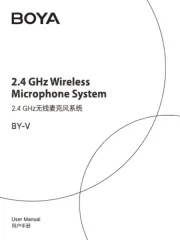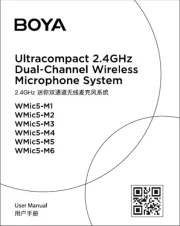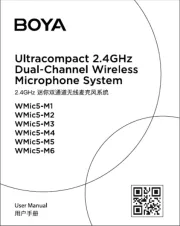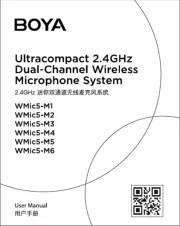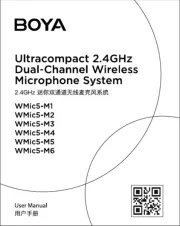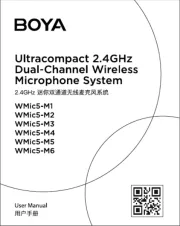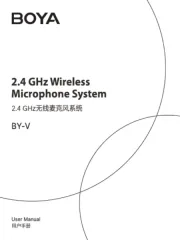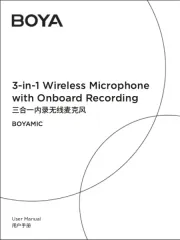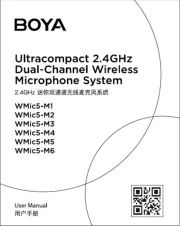www.boya-mic.com
Too much
ambience is
being picked
up.
When using an omnidir-
ectional microphone like
the one included with
this system, the
microphone may be
picking up too much
ambience.
Make sure the microphone is as
close as to the subject as possible.
Specications:
System
Troubleshooting
If you have any problem using the BY-WM8 Pro components, use
the following checklist.
If any problem persist, please consult our local dealer, or contact
us directly.
Symptom Meanings Remedy
The units does
not turn on
The polarity orientation of the
batteries in the battery
compartment is incorrect.
The batteries are exhausted. Replace the batteries with
new ones.
The battery terminals in the
transmitter are dirty
Clean the + and - terminals
with cotton swab.
Insert the batteries with the
correct polarity orientation.
The batteries
become drained
quickly.
The batteries are exhausted. Replace the batteries with
new ones.
Manganese batteries are being
used.
Use alkaline batteries. The
battery life of a manganese
battery is less than half that
of an alkaline battery.
The BY-WM8 Pro components
is being used under cold
conditions.
The batteries drain quickly
under cold conditions.
The channel
cannot be
changed
An attempt was made to
change the channel by
pressing the SET button only.
There is no
sound.
The channel setting on the
transmitter is dierent from
that on the receiver.
Use the same channel setting
on both the transmitter and
receiver.
The sound is
weak.
The attenuation level
on the transmitter is
too high.
The input level of the transmitter
is low. Press the button on the
transmitter in attenuation level
setting mode to decrease the
attenuation level.
The line input is selected
on the transmitter. Pull the cable out from LINE IN.
There is
distortion in the
sound
There is
distortion in the
sound
The attenuation level on
the transmitter is too low.
The input level of the receiver is
extremely high. Press the + button
on the transmitter in attenuation
level setting mode to increase the
attenuation level.
The transmitter and the
receiver are set to
dierent channels.
Set the transmitter to the
same channel.
Headphones with a mon-
aural min jack is used.
Use the headphones with a
stereo mini jack.
RF interference
.Try a dierent channel. Make sure
both units are on the same
channel.
.Try to position the antennas at a
45° angle in relation to each other.
There can be a lot of RF
interference outdoors.
.Try moving indoors, where there
is less RF interference.
.Keep the units' antennas at least
2'(0.6m) away from conductive
objects like metal and water.
.Overhead telephone lines,
uorescent lighting, and metal
fences can all cause interference.
.Turn o all nearby computers
and mobile phones.
The audio is
noisy or
distorted. This
can include drop
outs, white
noise, bursts,
pops and clicks.
The audio is
noisy or
distorted. This
can include drop
outs, white
noise, bursts,
pops and clicks.
RF signal is weak.
Make sure there is an unobstructed
line of sight between the
transmitter's and the receiver's
antennas.
Keep in mind that your body,
clothes, and onstage sets are
possible obstructions.
Make sure the receiver and
the transmitter are within
328'(100m) range.
If there are obstructions, you
may need to move closer.
The input level on the
camera, recorder, or
mixer is too high.
Turn down the audio input level on
your camera or recording device.
Lower the audio output level on
the receiver.
Turn down the gain on your mixer.
If there is no adjustment on the
device, and the level is still high,
adjust the microphone level on the
transmitter. Keep this level as high
as possible without distortion.
38 39 40
44 45
41 42
43
Restart the unit, then change
the channel with the + and -
buttons.
This device complies with part 15 of the FCC Rules.
Operation is subject to the following two conditions:
(1) This device may not cause harmful interference.
(2) This device must accept any interference received, including
interference that may cause undesired operation.
Warning: Changes or modications to this unit not expressly
approved by the party responsible for compliance could void the
user’s authority to operate the equipment.
NOTE: “This equipment has been tested and found to comply with
the limits for a Class B digital device, pursuant to Part 15 of the FCC
Rules.
These limits are designed to provide reasonable protection against
harmful interference in a residential installation.
This equipment generates, uses and can radiate radio frequency
energy and, if not installed and used in accordance with the
instructions, may cause harmfulinterference to radio communications.
However, there is no guarantee that interference will not occur in a
particular installation. If this equipment does cause harmful
interference to radio or television reception, which can be determined
by turning the equipment o and on, the user is encouraged to try to
correct the interference by one or more of the following measures:
Reorient or relocate the receiving antenna.
Increase the separation between the equipment and receiver.
Connect the equipment into an outlet on a circuit dierent from
that to which the receiver is connected.
Consult the dealer or an experienced radio/TV technician for help.
FCC STATEMENT:
RF warning statement:
The device has been evaluated to meet general RF exposure requirement.
The device can be used in portable exposure condition without restriction.
Transmitter B
Frequency Chart
Transmitter A
C hannel (C H) Frequenc y(MH z) C hannel(C H) Frequenc y(MH z)
1 556.710
2 557.120
3 557.530
4 557.940
5 558.350
6 558.760
7 559.170
8 559.580
9 559.990
10 560.400
11 560.810
12 561.220
13 561.630
14 562.040
15 562.450
16 562.860
17 563.270
18 563.680
19 564.090
20 564.500
21 564.910
22 565.320
23 565.730
24 566.140
25 566.550
26 566.960
27 567.370
28 567.780
29 568.190
30 568.600
31 569.010
32 569.420
33 569.830
34 570.240
35 570.650
36 571.060
37 571.470
38 571.880
39 572.290
40 572.700
41 573.110
42 573.520
43 573.930
44 574.340
45 574.750
46 575.160
47 575.570
48 575.980
C hannel(C H) Frequen cy(M H z) C hannel(C H) Frequenc y(M Hz)
1 576.390
2 576.800
3 577.210
4 577.620
5 578.030
6 578.440
7 578.850
8 579.260
9 579.670
10 580.080
11 580.490
12 580.900
13 581.310
14 581.720
15 582.130
16 582.540
17 582.950
18 583.360
19 583.770
20 584.180
21 584.590
22 585.000
23 585.410
24 585.820
25 586.230
26 586.640
27 587.050
28 587.460
29 587.870
30 588.280
31 588.690
32 589.100
33 589.510
34 589.920
35 590.330
36 590.740
37 591.150
38 591.560
39 591.970
40 592.380
41 592.790
42 593.200
43 593.610
44 594.020
45 594.430
46 594.840
47 595.250
48 595.660
PLL Synthesized Control Oscillator
556.71 MHz-575.98 MHz (Transmitter A)
576.39 MHz-595.66 MHz (Transmitter B)
48
40 Hz to 18 kHz (+/-3dB)
14° F to 122° F (-10 to +50 )℃ ℃
14° F to 131° F (-10 to +55 )℃ ℃
Oscillator type:
Carrier Frequency Range:
Channels:
Frequency response:
Operating temperature:
Storage temperature:
RF output power
Antenna
Spurious emission
Audio input connector
Reference audio input level
Reference deviation
Input frequency range
Distortion
Power supply
Dimensions:
Weight:
≤10 mW
1/4λ wire antenna
250nW or less
3.5mm jack
–60 dBV (MIC input, 0 dB attenuation)
±5 kHz (–60 dBV, 1 kHz input)
20Hz-20KHz
0.5% or less
Two AA size batteries
TX8 PRO:20.8 x 6.7 x 2.9 cm
BY-WXLR8 PRO:5.7x4.55x11.69cm
BY-WHM8 PRO: 5.3x5.3x25.6cm
TX8 PRO:81g (without batteries)
BY-WXLR8 PRO:162g (without batteries)
BY-WHM8 PRO: 252g (without batteries)
Receiver:
Lavalier Microphone
Antenna
Audio output connector
Signal to noise ratio
Distortion
Headphone output level
Audio output level
Power supply
Dimensions
Weight
1/4λ wire antenna
3.5mm jack
80dB or more
0.5% or less
30mW (16 Ω)
–60 dBV
Two AA size batteries
208 H × 67 W × 29 L mm ( ) ( ) ( )
95g without batteries
Back electret Condenser
Omni-directional
35Hz ~ 18 KHz
74dB SPL
-30dB +/-3dB / 0dB=1V/Pa, 1 kHz
3.5mm locking mini plug
1.2m (4’)
Transducer:
Polar pattern:
Frequency Range:
Signal / Noise:
Sensitivity:
Connector:
Length:
SHENZHEN JIAYZ PHOTO INDUSTRIAL., LTD.
The BOYA logo is a trademark which is registered and owned by
Shenzhen Jiayz Photo Industrial., Ltd.
COPY RIGHT 2010-2020
Email: sales@boya-mic.com
www.boya-mic.com / www.jiayz.com
Important Notes
Usage and storage
Operating the BY-WM8 Pro components near electrical equipment
(motors, transformers, or dimmers) may cause it to be aected
by electromagnetic induction.
The presence of the lighting equipment may produce electrical
interference over the entire frequency range. Position the
BY-WM8 Pro components so that interference is minimized.
To avoid degradation of the signal-to-noise ratio, DO NOT use the
BY-WM8 Pro components in noisy
Places or in locations subject to vibration, such as the following:
- Near electrical equipment, such as motors, transformers, or dimmers.
- Near air condition equipment or places subject to direct air flow from
an air conditioner.
- Near public address loudspeaker.
- Where adjacent equipment might knock against the receiver.
Cleaning
Clean the surface and the connectors of the BY-WM8 Pro components
with a dry, soft cloth. Never use thinner, benzene, alcohol or any
other chemicals, since these may mar the nish.
33 34 35 36 37
BY-WHM8 Pro
Wireless Handheld Microphone
4. PAIR
A. How to change Channel
1) Short press “PAIR” botton, the channel number blinks
2) Press “PAIR” botton again to change channel.
3) Wait 3 seconds till channel number doesn’t blink.
B. Long press “PAIR” botton to change Channel “A” or “B”.
5. Battery compartment
6. Battery cover
1. Power LED
2. LCD screen
For more details, please refer to “LCD Display Operation Guide”
on page 35.
3. Power OFF/ON
Installing Batteries
The transmitter is each powered by two AA batteries. To install
batteries, please follow these steps:
1. Turn the battery cover anti-clockwise to unscrew.
2. Push the “OPEN” bottom down.
3. Insert the batteries in the right polarity as shown.
4. Close the battery cover and retighten it by screwing clockwise
until it is reasonably tight.
NOTE:
1. Please make sure the units is turned OFF, because taking out the
battery compartment during signal transmission may cause high
noise.
2. Please remove the batteries from the microphone when the
microphone is not in use as current is drawn whenever a battery
is installed.
1
1
2
2
3
1
2
3
4
5
A
48
① )Channel Group (A/B
Long press “SET” botton to change Channel “A” or “B”
②Channel number (1-48)
③Battery indication
3
Connecting the wireless handheld microphone and the
receiver
To connect the wireless handheld microphone and the receiver,
follow these steps:
1. Turn on the wireless handheld microphone and the receiver.
2. Set the wireless handheld microphone and the receiver to the
same channel.
If you are experiencing interference or noise on one channel, try
a dierent channel.
6
Product Structure
LCD Display Operation Guide
Keep the BY-WM8 Pro components as far as from such equipment
as possible.
TX8 PRO , BY-WXLR8 PRO, BY-WHM8 PRO
